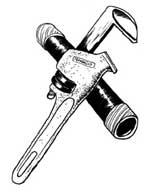|
Rain Gutters and Their Purpose Plus Tips and Hints For Installation
Rain Gutters play a very large roll in collecting and diverting rain water away from the foundation of your home preventing possible flooding. Surprisingly enough, they are rather easy to install with a few helpful tips and hints. Here’s what you will need: In an effort to catch the bulk of the water running off your roof, the gutters should be positioned so that the roof’s edge is over the center of the gutter. When it comes to vinyl gutters the thickness can make a huge difference. Although the thicker vinyl will cost more, it is well worth the price. Thinner vinyl has a tendency to sag under the weight of leaves and debris that tend to collect in a gutter over time.
Allow the proper slope of 1/4 inch for each 10 feet toward a downspout. That way, water will flow downhill to the downspout and eventually away from your home.Installing Rain Gutters:It’s time to do some calculations. At each end of the house measure down 1/2 inch length on the eves and make a mark. These two marks should be level with each other. Determine where your down spout will be placed. Remember, gutters need to slope downhill, so at each 10-foot section make a mark ¼ inch lower than the mark before it. Snap a chalk line between the lowest mark (on the downspout end) and the highest mark at the opposite end. The chalk line will be your reference line for installing your rain gutter. Now that you have your starting sloped line install the various components of the gutter system including corners and drop outlets starting at the lower end of the gutter. Also install the mounting brackets or hangers, which are generally, positioned every 24 or 30 inches. Be sure to follow manufacturer's specifications. Use galvanized screws to attach hardware while aligning all the components with your reference line. Cut required pieces to size. Gutter sections can now be snapped together in the hangers and the sections can be joined with connectors. Be sure to follow the manufacturer's directions for proper expansion and contraction of the vinyl. A hacksaw can be used to cut sections to lengths less than 10' when needed to finish a run. Sandpaper is used to smooth out and removes burrs left from the hacksaw on a piece of cut vinyl rain gutter. At the bottom of the drop outlet, install the elbows then measure, cut and install sections of downspout to the base of the drop outlet. Don’t forget to fasten it securely to the side of the house. To divert the rainwater away from the house use another elbow and a short section of downspout pointed away from your foundation. Finally, silicone all seams to make them water tight and test using a garden hose.
Return to Family Handyman Questions Home Page From Rain Gutters Page
|
Family Handyman Quick Links
Looking for a Toronto plumber? Hiring a plumber can effectively fix your plumbing!
Download free Handyman clipart
Download free Handyman Business forms


